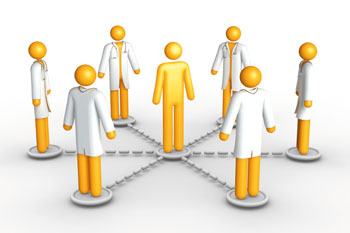Cancer Knowledge Cloud for a New Generation of Medicine
This article originally appeared in the 1 July 2009 of International Science Grid this Week
Thinking BIG Ken Buetow thinks BIG. He envisions what he calls a Cancer Knowledge Cloud — an IT environment designed to foster information connectivity among cancer patients, cancer researchers and clinical care providers. This environment, powered by caBIG ((cancer Biomedical Informatics Grid) ) tools and infrastructure, would enable a continuous and accelerated cycle of discovery, diagnostic and pharmaceutical product development, and improved clinical care.
Ken Buetow thinks BIG. He envisions what he calls a Cancer Knowledge Cloud — an IT environment designed to foster information connectivity among cancer patients, cancer researchers and clinical care providers. This environment, powered by caBIG ((cancer Biomedical Informatics Grid) ) tools and infrastructure, would enable a continuous and accelerated cycle of discovery, diagnostic and pharmaceutical product development, and improved clinical care.
Cancer care and research still operate on a linear, slow and cost-ineffective 20th-century model that fails to capture the value of clinical data, according to Buetow. He outlined the traditional model’s four sequential steps as discovery, product development, clinical care and outcomes. The discovery phase, he says, suffers from difficulty in accessing clinical outcomes data as well as high quality biospecimens. “Siloed” information and a lack of standing infrastructure for clinical trials hamper product development, and actual clinical outcomes are not captured systematically to further inform discovery research processes.
Buetow wants to move to a 21st century, continuous-loop model in which an “analysis and learning” phase connects from “outcomes” back to “discovery” (see figure below). This would allow clinical experience to figure into the mix for product development and then into the next iteration of clinical care. This model of a “learning healthcare system” cannot be achieved without IT connectivity.
Knowledge cloud for biomedical connectivity
Buetow describes the Cancer Knowledge Cloud as a virtual biomedical capability that uses caBIG to integrate distributed individual and organizational data, software applications, and computational capacity through the Internet. This capability requires standards to be established in order to exchange information. Comprised of tools, grid infrastructure, data standards, and policies, caBIG can furnish the semantic middleware infrastructure that binds the components together in a flexible way, as standards solidify and domains expand.
Because the biomedical community has not traditionally seen connectivity and data-sharing as desired objectives, Buetow and the NCI are also pioneering a new model of collaboration for academiae, government and industry. Called the BIG Health Consortium, this initiative is fostering an integrated and interactive ecosystem (or “mega-community”) of previously-unlinked sectors within life sciences and health care. They would work collaboratively to make a new generation of medicine — personalized, predictive, preemptive and participatory — a reality.
The stars are aligning
The time is right for the Cancer Knowledge Cloud, according to Buetow, due to a convergence of factors. The caBIG software deployment is mature enough, with software packaged in easy-to-install bundles that include online tutorials, videos and documentations, he says. Then there’s the availability of the software's knowledge centers and support service providers that underpin a viable user community. At the same time, the rate of scientific discovery is accelerating to unprecedented levels, and a shift is underway towards the development of molecularly-based diagnostics and therapeutics. Overall, there is growing recognition of the urgent need for change within biomedicine.
“We live in extraordinary times,” notes Buetow. “And the Cancer Knowledge Cloud is a natural evolutionary step for boosting the biomedical enterprise into the 21st century knowledge economy.”
Anne Heavey, iSGTW

